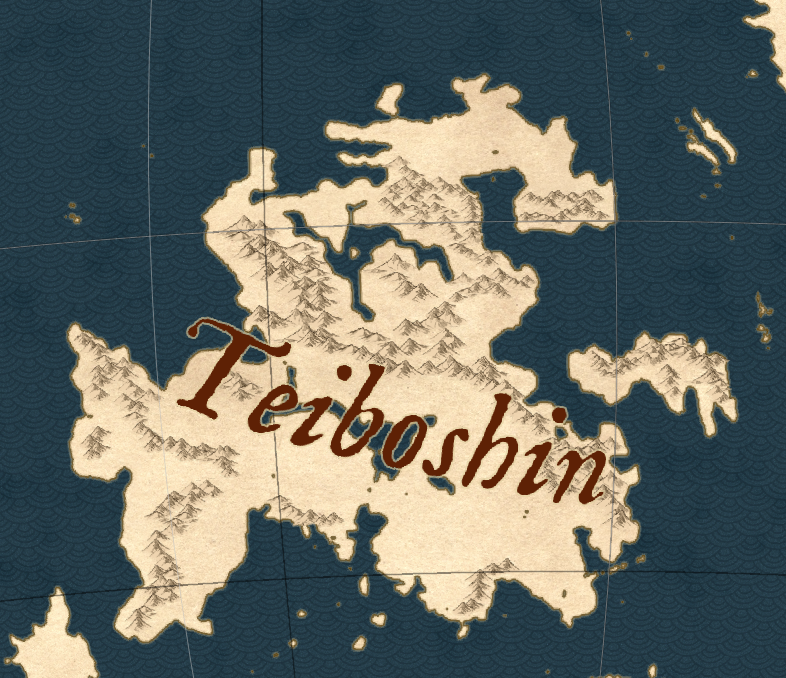Kwerubán (丁戊申)
Known to the High Elves as Teiboshin (丁戄申), but called Kwerubán by its oldest peoples—"The Place of Ancestral Walking"—this great land is the cradle of humanity on Erthas. It is here that the first breath of the Maŋgwəta peoples stirred beneath rain-soaked leaves, and the great families of Earthwalkers spread across mountain, forest, fire, and plain.
Geography
Kwerubán spans over 12 million square kilometers, stretching primarily across the southern hemisphere, with its northern jungles reaching above the equator. It is defined by dramatic biomes and topographical diversity:- Western Monsoon Highlands: Towering mountains rim the continent's west, cloaked in monsoon rainclouds and dense slope-forests. Their volcanic spines are sacred to several ancestral traditions.
- Southern Savannahs: Rolling plains dotted with stone outcroppings and acacia trees form the heartland of migratory cultures. Fire-hardened tools and walking chants echo across the grass.
- Central Rainforest Belt: A lush equatorial jungle bursting with medicinal bark, foraging trails, and voice-filled canopies. This region is a convergence zone for language, lineage, and memory.
- Interior Plateaus: Gently rolling highlands serve as crossroads for migration. Known for shell-path waystones and ancestral map-trees, they connect every region of Kwerubán.
- Northern Savannah and Jungle Fringes: A mixture of forest, grassland, and marsh inhabited by fire-walkers and ridge-dwellers. Seasonal floods shape both travel and storykeeping.
- Eastern Monsoon Coast: Fertile lowlands bathed in rhythmic rainfall. Glider reptiles and spiral-net fishers inhabit this fog-washed margin.
- Southern Coastal Desert: Windswept dunes and sun-cracked clay pans mark the continent's southern edge. Sacred echoes and fossil-seekers haunt the hollow basins.
Peoples and Languages
Kwerubán is the origin point of five major language families:- Bɛnkwáta (Proto-Niger-Congo) – Root-speaking peoples of breath and trail. Found across the western monsoon (Kāmbeni branch: Ndawere, Tobani, Erhulo), the central plateau and southern savannah (Mwazeki branch: Onjole, Tandari, Vúketa).
- Zundʉta (Proto-Bantu) – River-path wanderers and storytellers. Present primarily in the south (Tsandi branch: Rokholo, Bendeta).
- Chalaxa (Proto-Cushitic) – Salt-fire foragers and mist-coast travelers. Found in the western monsoon (Haynara branch: Isselani, Mururo, Tazemu), central jungle (Yashari branch: Arenzi, Kumeko, Baleti), northern savannah (Gɔrta branch: Zerhanu, Tekoma), and northern jungle (Afere branch: Mileko, Ziyali).
- Khoŋta (Proto-Khoi-San) – Cliff-click singers and echo-keepers. Widely distributed in the western monsoon (Thlaga branch: ǂTikwa, ǁHoromi), southern savannah (Xhondo branch: ǁGoruma, !Nekwe, ǀKeta, ǃUshana, ǂMbuko), central jungle (Lhara branch: ǀSimu, ǃThwene, ǂAkari, ǃNgule, ǁBhetha), northern savannah (Thara branch: ǀTshama, ǃGhamu, ǁRiwa, ǀNoshu, ǂFhuta), northern jungle (Nkhani branch: ǃObani, ǂDheto, ǀXhuma), and eastern monsoon coast (Ikhura branch: ǁSuru, ǃAkute, ǂLamani).
- Ndotēra (Proto-Nilotic) – Stone-blood journeyers who trace ancestry through fire and shadow. Located in the southern savannah (Mbukuru branch: Ekwoni, Damuta).
Lifeways
The humans of Kwerubán are nomadic foragers, cliff dwellers, canopy weavers, and fire-walkers. Their technology includes:- Resin-bound stone blades, shell scrapers, and bark baskets
- Flint mirrors for fire-dancing and signal rites
- Driftwood bone-flutes and skin drums for ancestral breath songs
- Rain traps, sky nets, and vine-sling traps in jungle and plateau










Comments